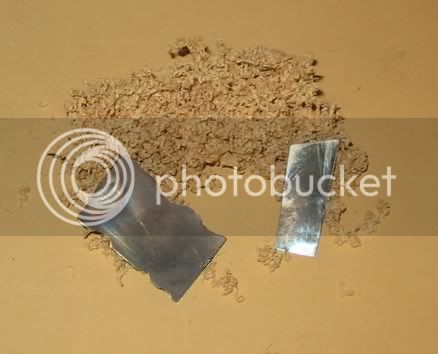
These are two little scrapers I built for the current gun I'm working on.
The pointed one worked very well for removing wood on the sides of the butt right down to the incised line I had made.
Unlike sandpaper which has been known to remove the sharp edges you sometimes want in an area, the scraper is easy to control (most of the time) and use.
The only times I had difficulty was when it wanted to chatter over the curl of the stocks wood.
I found that lightly sanding the area, and reversing the direction of the scraping permitted it to go back to work removing just what I wanted removed.
The blade with the curved cuts in it was used for reducing the diameter of the Hickory ramrod. The pile of shavings are a small part of the pile that came off of the ramrod.
As I was working on the ramrod, a thought came to me. (frightening! :shocking
By using the scraper, if any end grain would have been coming out of the side (a definite no-no on a ramrod), I would have known about it because the scraper would have snagged on it like it did with the curly Maple.
These scrapers were made out of spring steel and hardened in water. Then they were heated to bring them to spring temper, or a little softer. (Note the blue color).
You could use any steel for these, and hardening isn't really required. In fact, it makes rolling the edge more difficult than if I would have left them soft.
Rolling the edge is how you change a scraper from being a scraper to actually being a cutting tool.
After you have the form or shape you want, place the blade in a vise with the cutting surface up.
Holding it at a angle to the side of the scraper, use a drill shank or the tang of a file and work it back and forth along the edge. This will roll the material over the edge making a almost invisible but feelable burr.
This burr will act as a very small cutting blade when it is "scraped" along on the wood, producing the shavings as shown in the pile.
Just out of curiosity, I measured the thickness of some of these shavings. They were .0010-.0015 thick which is indicative of the precision you have when using this method. ::
You want .006-.008 of wood removed? Just take about 6 passes with your scraper. I doubt that ole "Power Tool" Norm on
The New Yankee Workshop works to those types of tolerances!! ::
If your scraper seems to grab and skip, you probably have too much edge rolled over. Sand or file the edge off and create a new smaller, less aggressive cutting edge.
As I mentioned, this edge should be so small, you can't see it. It should only be felt by running your finger nail from the face of the blade across the edge towards the contour.





